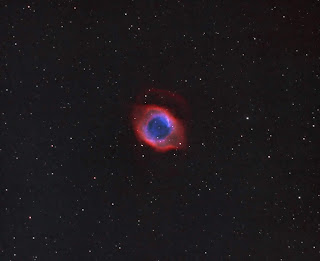New Mount, New Camera, New Images
In December 2018, my old Meade LXD75 mount suffered a total R.A. motor failure. After a decade of far better service than I should have expected -- the LXD line was not Meade's best or most accurate equatorial mount -- it was time to move on. After considerable research, I settled on the Sky Watcher EQ6-R Pro, which I ordered through Highpoint Scientific.
The new mount quickly proved far more capable and reliable than the LXD, which was not unexpected. Since I had upgraded the mount, I decided it was time to do likewise with the camera. I had been using a Gary Honis-full spectrum modified Canon EOS T2i since 2014 and had reached its limits. After more research, I settled on a ZWO ASI1600MM Pro. This was a major change from the one-shot-color (OSC) imaging that I had been doing for years. But a switch to Mono (a monochrome chip), seemed like the next step in my imaging development. So I took the plunge. Since I still wanted to capture color images, and because I was interested in using Narrowband filters, I selected the ASI1600MM Pro kit with an electronic filter wheel and 31mm L, R, G, B, Ha, OIII and SII filters.
Naturally, once the new camera arrived in early April, six weeks of clouds and rain followed. During that time, I decide that, having spent money on a new mount and camera, I might as well purchase a new scope to go with them. I had grown a little tired of constantly collimating my 6" Orion Newtonian Astrograph, so I purchased a Sky Watcher Evostar 72 ED, a 72mm doublet refractor, which promised a very wide field of view. With the added .8 field flattener/reducer that already wide field was widened even more.
Having indulged myself with a new mount, camera and telescope, I decided to spend even more money. I purchased Pixinsight, the leading astro-imaging processing software and took a subscription to Photoshop. At this point, why not?
Between the software and camera, there was an inevitable learning curve, but by June, I was amazing myself with images that far better matched what I had long hoped to achieve in astro-imaging. The ASI1600 has proven extremely versatile and sensitive, allowing me to capture objects that were just too faint for the DSLR (and SSP before it). I had long avoiding Mono imaging because I figured it would be too difficult. However, the reality is that with contemporary electronic filter wheels and software (I use Astrophotography Tool - APT), the process is relatively simple. There are a few more steps, but not many, and the results amply justify the extra effort.
So, here are some of the highlights of the last eight weeks, through mid August.
NGC 884 & 869 - The Double Cluster
A preview of fall's coming attractions. Less than 20 minutes of exposure through RGB.
M8, M20 and NGC 6559
I am particularly pleased with this image, which captures M20, the Trifid Nebula (upper middle/right), M8, the Lagoon Nebula (lower right) and NGC 6559 (lower left), in one image. More so, because this is actually two images that Pixinsight combined into a mosaic. The 72ED's FOV is generous enough the capture M8 and M20 in one shot, but not all three objects.
M11 - The Wild Dust Cluster
Under 20 minutes of RGB exposure time, but enough to bring out the dense starfield and wispy dark nebula in the region around the cluster.
M27 - The Dumbbell Nebula
This image is one of my first Narrowband images, a combination of Ha and OIII subs.
M31 - The Andromeda Galaxy
Another preview of fall. This image is composed of just over 30 minutes of 60-second RGB subs, which shows the considerable power of the ASI1600.
NGC7635, M52 & Friends
This image truly brought home the power of mono imaging and the sensitivity of the ASI1600. I have been imaging the beautiful cluster M52 (top/center) and NGC 7635, the Bubble Nebula (mid center/left), and NGC 7538 (lower center/right) for years, completely unaware of the other objects - Sh2-157 (the Lobster Claw - lower left) and extended nebulosity between NGC 7635 and NGC 7538 (mid to lower right). The DSLR was simply not sensitive enough to capture them.
NGC 7000 and NGC 5070
This mosaic of two images capturing the North American Nebula (NGC 7000) and the Pelican Nebula (NGC 5070) puts just about every astro-image I'd taken before to shame. This image is under an hour of HaRBG integration, with subs of just 60 seconds.
NGC7023 - Iris Nebula
Notoriously difficult to bring out the dust clouds surrounding the Iris, but at just 5 hours of RGB integration, the ASI1600 does a good job.
NGC7293 - The Double Helix Nebula
Just under eight hours of Ha and OIII, with subs ranging from 600 seconds to 180 seconds.
NGC7822
A region of emission nebula and star clusters in Cepheus.
Sh2-101 - The Tulip Nebula
About an hour RGB integration in Cygnus.
Sh2-157 - The Lobster Claw
Spotted whilst imaging the Bubble Nebula (NGC 7635 - upper center/right), the Lobster Claw demanded its own image. About two hours of integration in RGB using 300-second subs.
































